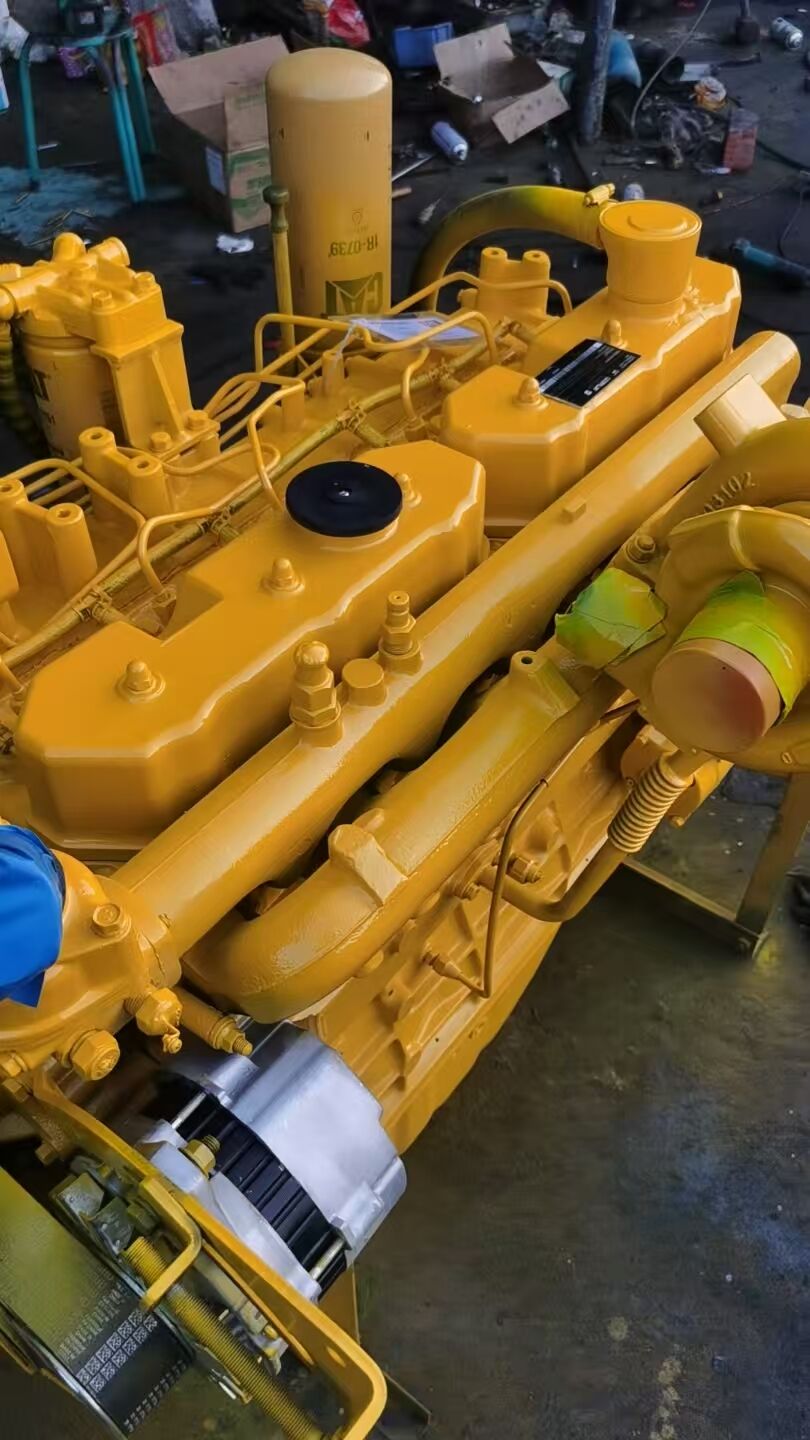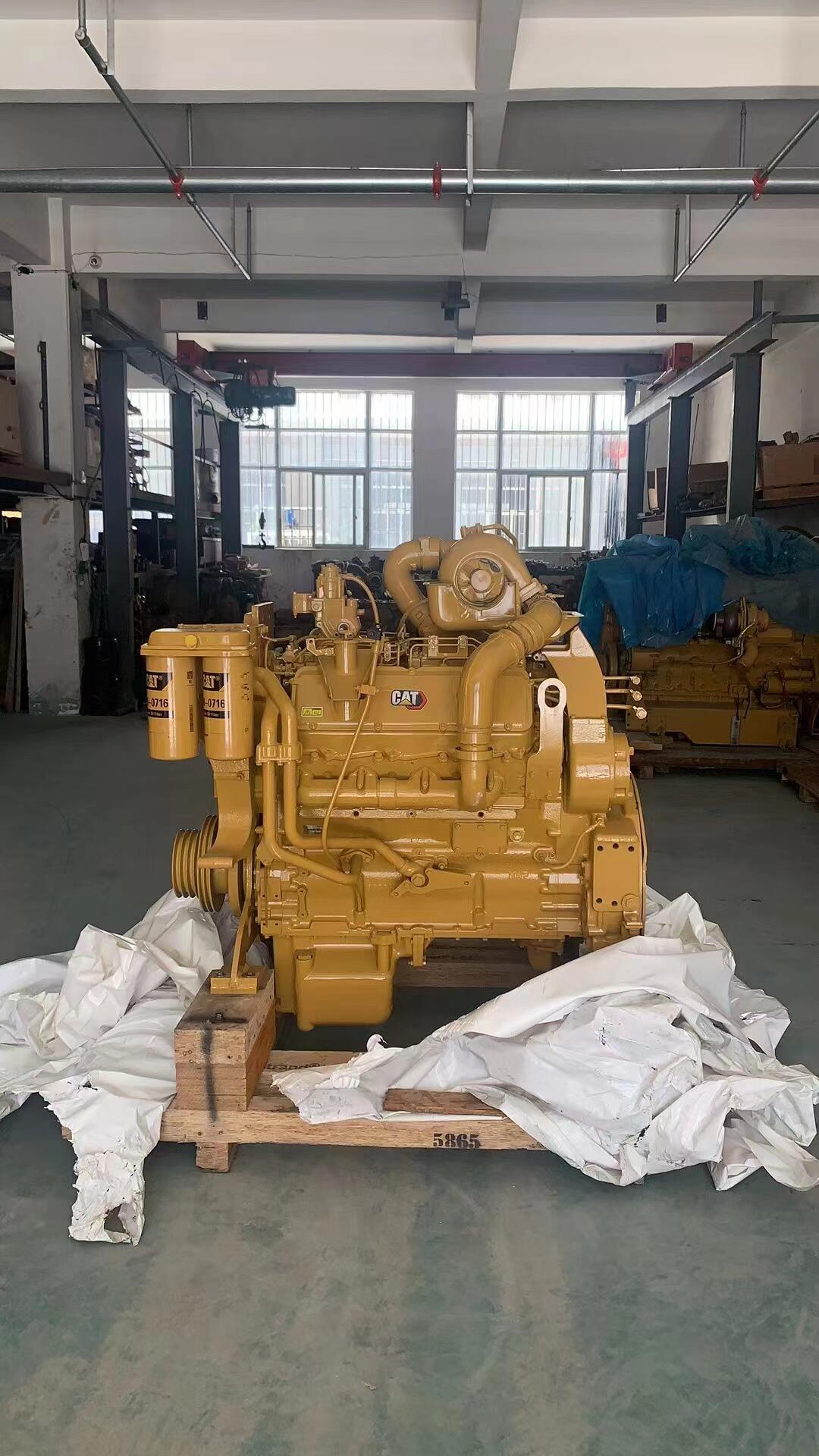Maksimal performans üçün Caterpillar mühərrikinin necə düzgün təmir ediləcəyi Caterpillar Motoru performansın artırılması üçün
Caterpillar mühərriklərinin təmirinə giriş
Caterpillar mühərriki tikinti, qazma, nəqliyyat və enerji istehsalı kimi müxtəlif sektordan dünyanın dörd bucağında möhkəmlik, güc və davamlılığı ilə tanınır. Bu mühərriklər planetin ən ağır şərtlərində işləmək üçün nəzərdə tutulmuşdur və ağır maşınlar və nəqliyyat vasitələri üçün etibarlı güc təmin edir. Bununla belə, nə qədər möhkəm olursa olsun, maksimal performansını saxlamaq üçün müntəzəm və ətraflı təmir tələb olunur. Düzgün qayğı yalnız effektivliyi və uzunömürlülüyü təmin edmir, həm də yanacaq, təmir və dayanma zamanı xərclərdə qənaətə kömək edir. Caterpillar Motoru olsun, o, hələ də maksimal performansını saxlamaq üçün müntəzəm və ətraflı təmir tələb edir. Düzgün qayğı yalnız effektivliyi və uzunömürlülüyü təmin edmir, həm də yanacaq, təmir və dayanma zamanı xərclərdə qənaətə kömək edir.
Bu məqalə investisiyanızın maksimum effektivliyini təmin etmək üçün avtomobilin düzgün qorunmasını necə həyata keçirmək barədə ətraflı təlimat verir Caterpillar Motoru yanacaq sistemləri, yağlama, soyutma, hava daxilolma, emissiya və operatorların ən yaxşı təcrübələri barədə danışılır və həm fərdlərə, həm də avtomobillər parkının operatorlarına kömək edir.
Müntəzəm Baxımın Əhəmiyyəti
Nə üçün profilaktik müalicə vacibdir?
Ən davamlı mühərriklər belə nəzarətsiz qalıbsa, keyfiyyəti aşağı düşəcək. Qabaqlayıcı texniki xidmət kiçik problemləri ciddi nasazlıqlara çevrilməzdən əvvəl aşkar etməyə kömək edir. Caterpillar mühərriki üçün bu, filtrlər, qövslər, remniyollar və inyektorlar kimi tez xarab olan hissələrə diqqət yetirməyi, həmçinin sistem performans göstəricilərini izləməyi nəzərdə tutur. Qabaqlayıcı texniki xidmət yalnız böyük nasazlıqlardan qoruymur, həm də istehsalçının tövsiyələrinə və zəmanət şərtlərinə riayət etməni təmin edir.
Xərclər və Uzunmüddətli Fəydər
Müntəzəm texniki xidmət müəyyən vaxt və resurs tələb etsə də, avariya hallarında ediləcək təmir işlərindən xeyli sərfəli hesab olunur. Proaktiv xidmət göstərmə, gözlənilməz dayanma riskini azaldır ki, bu da işlədiyiniz hər bir saati əhəmiyyətli olan sektorda əhəmiyyətli məhsuldarlıq itkisinə səbəb ola bilər. Operatorlar üçün texniki xidmət həmçinin ümumi istismar xərclərinin azalmasına və avtomobilin daha yaxşı satış dəyərinə çevriləcəyinə də kömək edir.
Yanacaq sisteminin qayğısı
Təmiz yanacaqın əhəmiyyəti
Caterpillar markalı mühərrik istehlak etdiyi yanacaq keyfiyyətindən asılı olaraq işləyir. Çirklənmiş və ya aşağı keyfiyyətli dizel yanacaq püskürtmə форсунка-larını tıxanmasına, yanma effektivliyinin azalmasına və yanacaq sisteminin iş vaxtının qısalmasına səbəb ola bilər. Bunu qarşısını almaq üçün həmişə yüksək keyfiyyətli yanacaqdan istifadə edin və yanacaq saxlama şərtlərinin düzgün olmasını təmin edərək su və ya zibil çirklənməsini qarşısını alın.

Yanacaq filtrləri və enjektorları
Yanacaq filtrlərinin vaxtında dəyişdirilməsi çox vacibdir. Kirlənmiş filtrlər yanacaq axışını məhdudlaşdırır və mühərrikin daha çox işləməsinə səbəb olur, bu da səmərəliliyin və gücün azalmasına gətirib çıxarır. Müntəzəm olaraq inyektorları yoxlayın, çünki nasaz inyektorlar yanacağın bərabərsiz təchizinə, artıq tüstüyə və performansın azalmasına səbəb ola bilər. İnkyektorların düzgün kalibrlənməsi və təmizlənməsi yanacaq sisteminin ən yüksək səviyyədə işləməsini təmin edir.
Yağlama Sisteminin Təmiri
Yağın Düzgün Növünü Seçmək
Yağlama Caterpillar mühərrikinin daxilində sürtünməni və aşınmanı minimuma endirmək üçün vacibdir. Həmişə Caterpillar tərəfindən sizin mühərrik modeliniz üçün tövsiyə edilən yağ markasından istifadə edin. Yanlış yağdan istifadə yağlama keyfiyyətini pozur, xüsusilə yüksək temperaturlarda iş rejimində.
Yağın Dəyişdirilməsi və Monitorinqi
Yağın müntəzəm fasilələrlə dəyişdirilməsi vacibdir. Təzə yağ çirkləndiriciləri aradan qaldırır və hamar iş üçün düzgün özlülüyü saxlayır. Yağ səviyyəsini gündəlik yoxlayın və daxili aşınma, məsələn, porşen halqalarının zədələnməsi və ya qövdələrin sızması göstərə biləcək abnormal yağ istehlakını yoxlayın. Həmçinin yağ təzyiqi monitorinq sistemlərinin quraşdırılması vaxtında problemləri aşkar etməyə kömək edir.
Soyutma sisteminin təmiri
İsınmanın Önənəsi
İsti işıqlanma Caterpillar mühərrikinə ciddi zərər vura bilər. Bunun qarşısını almaq üçün əməliyyatdan əvvəl mütləq maye səviyyəsini yoxlayın və sızma əlamətlərini yoxlayın. Radyatorun zibil hissələrindən təmizləndiyinə və hava axınının maneəsiz olduğuna əmin olun.
Mayenin keyfiyyəti və dəyişdirilməsi
Zaman keçdikcə maye keyfiyyəti aşağı düşür və korroziyadan qorumaqla temperaturun nizamlanması qabiliyyətini itirir. Caterpillar tərəfindən təsdiqlənmiş maye formulalarından istifadə edin və soyutma sistemini tövsiyə olunan müddətdə yuyun. Mayenin pH səviyyəsinin monitorinqi də komponentlərin erkən aşınmasının qarşısını almağa kömək edir.
Su nasosu və termostata yoxlama
Su nasosu və termostat mühərrikin temperaturunu tənzimləmək üçün çox vacibdir. Bu komponentləri daim aşınma və ya pozğunluq üçün yoxlayın. Qüsurlu bir termostat çox istiləşməyə səbəb ola bilər, zəif bir su nasosu isə kifayət qədər soyutma mayesinin dövriyyəsini təmin edə bilməz.
Hava Daxili və Turboşarjer Sistemləri
Hava Filtrləri
Səmərəli yanaşma üçün təmiz hava vacibdir. Kirli hava filtrləri hava axınıni azaldır, bu da qeyri-tam yanmaya, yanacaq səmərəliliyinin azalmasına və emissiyaların artmasına səbəb olur. Havanı filtrləyənləri, xüsusilə də tozlu yerlərdə mütəmadi olaraq yoxlayın və lazım olduqda onları dəyişdirin.
Turboşarın təmiri
Bir çox Caterpillar mühərrik modeli performansını artırmaq üçün turboşarcılardan istifadə edir. Turboşarjçılar düzgün işləmək üçün düzgün yağlandırma tələb edir. Uzun müddət boş hərəkət etmək minimum olmalıdır, çünki turboya yük qoyur. Mühərrikin ağır istifadədən sonra soyumasına icazə vermək, turbo komponentlərini istilik stresindən qoruyur.
Yanacaq və Tullantı Sistemləri
Yanacaq Qazının Təkrar Dövri Sistemi
EGR sistemləri ilə təchiz edilmiş müasir Caterpillar mühərrikləri üçün karbon yığılması performansı təsir edə bilər. EGR klapanı və soyutucunun təmizlənməsi və yoxlanılması tıxanmanı qovzamağa və emissiya tələblərinə uyğunluğun təmin edilməsinə kömək edir.
Dizel hissəcik filtrləri
Dizel hissəcik filtrləri ilə təchiz edilmiş mühərriklər regenerasiya dövrlərinin müntəzəm monitorinqini tələb edir. DPF təmirinin nəzərə alınmaması tıxanmalara və səmərəliliyin azalmasına səbəb ola bilər. Dövri təmizləmə və ya əvəz edilmə emissiya standartlarına uyğunluğun davam etdirilməsini təmin edir.
Elektrik və sensor sistemləri
Batareya və Alternator
Güclü elektrik sistemi Caterpillar mühərrikinin etibarlı başlamasını və sabit işləməsini təmin edir. Batareya yükünü yoxlayın və terminalları təmizləyin. Elektrik nasazlıqlarını qovzamaq üçün alternatorun performansı da yoxlanılmalıdır.
Sensorlar və Diaqnostika
Müasir Caterpillar mühərrikləri temperaturu, yanacaq axını, təzyiqi və emissiyanı izləyən inkişaf etmiş sensorlarla təchiz edilmişdir. Xətalı sensorlar səhv göstəricilərə, pis işə düşməyə və ya hətta mühərrikin sönməsinə səbəb ola bilər. Dövri diaqnostika testləri aparmaq və xətalı sensorları orijinal hissələrlə əvəz etmək, düzgün məlumatların alınmasını və mühərrikin hamar işləməsini təmin edir.
Operator üçün ən yaxşı təcrübələr
İstiləşmə və soyutma prosedurları
İsti və soyuq işə başlama prosedurları vacibdir. Caterpillar mühərrikinin istimlənməsinə imkan verərək yağın və soyutma mayesinin ağır yük tətbiq edilməzdən əvvəl optimal iş temperaturuna çatmasını təmin edin. Eynilə, mühərriki söndərməzdən qısa müddət boş işlətmək turboşarjerin soyumasına imkan verir və istilikdən yaranan zərəri azaldır.
Uzun müddətli boş işlətməkdən çəkinin
Uzun müddətli boş işlətmə karbonun yığılmasına, yağın çirklənməsinə və yanacağın itirilməsinə səbəb olur. Operatorlar uzun gözləmə dövrlərində də daxil olmaqla, aktiv istifadə olunmadıqda mühərriki söndürərək boş işlətməni minimuma endirməlidirlər.
Yükün izlənilməsi
Cat yük məhdudlamaları daxilində işlədilməsi daxili komponentlərə gərginliyi azaldır. Artıq yüklənmə soba sobası, həddən artıq aşınma və motorun iş vaxtının qısalmasına səbəb ola bilər.
Əsl hissələrin və peşəkarların əhəmiyyəti Xidmət
Orijinal Caterpillar hissələri
Təmir və təmir zamanı orijinal Caterpillar hissələrindən istifadə uyğunluq, etibarlılıq və uzunmüddətli məhsuldarlığı təmin edir. Bazar sonrası hissələr əvvəlcə ucuz ola bilər, lakin tez-tez dayanıqlılığın azalmasına və potensial sistem sıradanlıqlarına səbəb olur.
Sertifikatlı xidmət mərkəzləri
Sertifikasiyalı Caterpillar xidmət mərkəzlərinə etibar etmək təmirin bu mühərriklər üçün xüsusi təlim keçmiş texniklər tərəfindən aparıldığını təmin edir. Bu, ən son diaqnostika alətlərinə çıxış imkanı yaradır və zəmanət müddətini saxlayır.
Müvafiq təmirdən uzunmüddətli faydalar
Ciddi qayğı ilə qorunan Caterpillar mühərriki əla performans, aşağı işlətmə xərcləri və dayanma vaxtının azalmasını təmin edir. Park operatorları üçün bu, daha yüksək məhsuldarlıq və gecikmələrin azalması deməkdir. Fərdlər üçün isə etibarlı işləmə və avadanlığın daha yüksək satış dəyəri deməkdir. Düzgün texniki xidmət həmçinin emissiya standartlarına uyğunluğu təmin edir və ətraf mühitə məsuliyyətə töhfə verir.
Nəticə
Maksimum performans üçün Caterpillar mühərrikinin texniki xidməti yanacaq sistemlərini, yağlama, soyutma, hava daxili, istilik aralığı, elektrik sistemlərini və operativ təcrübələri əhatə edən kompleks yanaşma tələb edir. İstehsalçı təlimatlarını izləməklə, orijinal hissələrdən istifadə etməklə və sertifikatlı xidmətə etibar etməklə operatorlar mühərriklərinin ömrünü əhəmiyyətli dərəcədə uzada bilər və uzunmüddətli xərcləri azalda bilərlər. Caterpillar mühərriki əsas investisiyadır və ardıcıl texniki xidmət bu investisiyanı qorumağın ən yaxşı yoludur və illərlə ərzində etibarlı güc təmin edir.
SSS
Caterpillar mühərrikinə nə qədər tez texniki xidmət göstərməliyəm?
Xidmət intervalları modeldən və istifadədən asılı olaraq dəyişir, lakin ən yaxşı yanaşma Caterpilların təlimatında göstərilən texniki xidmət cədvəlinə əməl etməkdir.
Caterpillar mühərriki üçün hansı növ yağdan istifadə etməliyəm?
Mühərrik modeliniz üçün Caterpillar tərəfindən tövsiyə edilən yağ markası və spesifikasiyalarından istifadə edin.
Caterpillar mühərrikində soba qızmasının qarşısını necə almaq olar?
Soyutma mayesi səviyyəsini müntəzəm yoxlayın, radiatordan təmiz saxlayın və su nasosları və termostatları düzgün işləməsi üçün yoxlayın.
Həddən artıq işləmə Caterpillar mühərrikinə zərər verə bilərmi?
Bəli, həddən artıq işləmə karbon yığılmasına, yanacağın itirilməsinə və artırılmış aşınmaya səbəb olur, bu da səmərəliliyin və ömrünün azalmasına səbəb olur.
Niyə orijinal Caterpillar hissələrindən istifadə etməliyəm?
Bu hissələr xüsusi olaraq Caterpillar mühərrikləri üçün hazırlanmışdır və möhkəmliyin, uyğunluğun və zəmanət qorunmasının təmin edilməsini təmin edir.
Caterpillar mühərrikində sıçan probləmlərinin əlamətləri nədir?
Simptomlar sərbəst işləmədə zənginləşmə, yanacaq sərfiyyatının artırılması, işə düşmədə çətinlik və çoxluqda istismar dumanı daxildir.
Caterpillar mühərrikləri xüsusi maye istifadəsi tələb edirmi?
Bəli, Caterpillar tərəfindən təsdiqlənmiş mayelər korroziyanı qarşısını almaq və temperaturu effektiv şəkildə tənzimləmək üçün düzgün kimyəvi balansı təmin edir.
Caterpillar mühərriyimin işlək müddətini necə artırabilərəm?
Müntəzəm texniki xidmət cədvəlinə əməl edin, orijinal hissələrdən istifadə edin, artıq yüklənmədən çəkinin və istiləşmə və soyutma prosedurlarına riayət edin.
Caterpillar mühərriyimi özüm texniki xidmət edə bilərəmmi?
Yağ, filtrlər və maye səviyyəsinin yoxlanılması kimi əsas vəzifələri operatorlar özü həyata keçirə bilər, lakin əsas texniki xidmət sertifikatlı texniklər tərəfindən yerinə yetirilməlidir.
Caterpillar mühərriklərindən hansı sektoralar ən çox faydalanır?
Tikinti, mədənçıxarma, kənd təsərrüfatı, dənizçilik və enerji istehsalı sənayeləri etibarlı performans üçün Caterpillar mühərriklərinə çox etibar edir.
Mündəricat
- Maksimal performans üçün Caterpillar mühərrikinin necə düzgün təmir ediləcəyi Caterpillar Motoru performansın artırılması üçün
- Caterpillar mühərriklərinin təmirinə giriş
- Müntəzəm Baxımın Əhəmiyyəti
- Yanacaq sisteminin qayğısı
- Yağlama Sisteminin Təmiri
- Soyutma sisteminin təmiri
- Hava Daxili və Turboşarjer Sistemləri
- Yanacaq və Tullantı Sistemləri
- Elektrik və sensor sistemləri
- Operator üçün ən yaxşı təcrübələr
- Əsl hissələrin və peşəkarların əhəmiyyəti Xidmət
- Müvafiq təmirdən uzunmüddətli faydalar
- Nəticə
-
SSS
- Caterpillar mühərrikinə nə qədər tez texniki xidmət göstərməliyəm?
- Caterpillar mühərriki üçün hansı növ yağdan istifadə etməliyəm?
- Caterpillar mühərrikində soba qızmasının qarşısını necə almaq olar?
- Həddən artıq işləmə Caterpillar mühərrikinə zərər verə bilərmi?
- Niyə orijinal Caterpillar hissələrindən istifadə etməliyəm?
- Caterpillar mühərrikində sıçan probləmlərinin əlamətləri nədir?
- Caterpillar mühərrikləri xüsusi maye istifadəsi tələb edirmi?
- Caterpillar mühərriyimin işlək müddətini necə artırabilərəm?
- Caterpillar mühərriyimi özüm texniki xidmət edə bilərəmmi?
- Caterpillar mühərriklərindən hansı sektoralar ən çox faydalanır?

